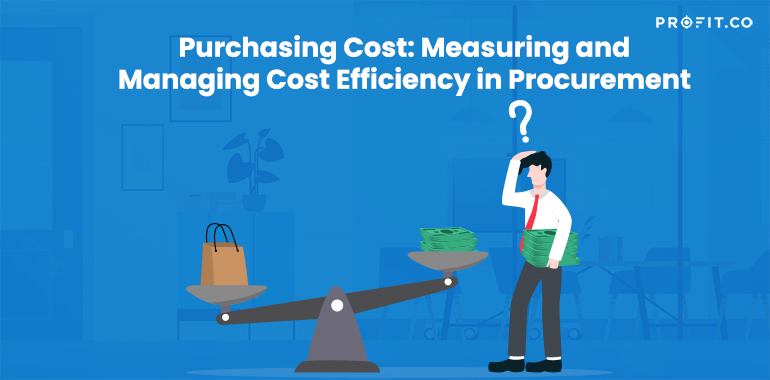Introduction
Step into the dynamic world of business, where the ability to conquer costs holds the key to accessing remarkable success. Among the arsenal of business strategies lies a true gem: Key Performance Indicators (KPIs), the relentless warriors in the battle for financial control. Monitoring these KPIs can help organizations control costs, make informed purchasing decisions, and identify areas for improvement in their procurement strategies. Learn all about the KPI that is important in the field of procurement and supply chain management—Purchasing Cost KPI.
This blog post is your gateway to a profound understanding of the Purchasing Cost KPI, empowering you with the knowledge to transcend mere excellence by helping you understand the Purchasing Cost KPI, including its definition, significance, and formula to calculate it.
Automation applied to an inefficient operation will magnify the inefficiency
Definition of Purchasing Cost KPI
The Purchasing Cost KPI measures the total cost incurred by a company during the procurement process. It includes all direct and indirect expenses associated with purchasing goods or services, such as purchase price, transportation costs, taxes, duties, packaging, and handling charges. This KPI helps organizations evaluate their purchasing performance, identify cost-saving opportunities, and optimize their procurement strategies.
To Discover how the Purchasing Cost KPI transforms procurement and drives cost optimization
Formula to Calculate Purchasing Cost KPI with Real-Time Example
Let’s consider a manufacturing company called ABC Electronics that produces Smartwatches. They want to measure their Purchasing Cost KPI to evaluate the efficiency and effectiveness of their procurement process.
Here’s an example of how the formula can be applied in their case
ABC Electronics purchases various components such as screens, batteries, processors, and casings from suppliers. Quantity of Items Purchased = 10,000
The total cost of goods or services purchased
Transportation costs: To have the components delivered to their manufacturing facility, ABC Electronics incurs transportation expenses. In this example, they spent $100,000 on transportation.
Taxes and duties: When importing certain components, the company is required to pay taxes and duties. Let’s assume that the taxes and duties amount to $50,000.
Packaging and handling charges: ABC Electronics incurs charges for packaging the components and handling them within their facility. For this example, they spent $20,000 on packaging and handling.
Now, we can calculate the Purchasing Cost KPI for ABC Electronics:

Quantity of Items Purchased = 10,000
Purchasing Cost KPI = $1,170,000 / 10,000
Purchasing Cost KPI = $117 per item
Therefore, the corrected Purchasing Cost KPI for ABC Electronics in this example is $117 per item.
This KPI can be used by ABC Electronics to assess the efficiency of its procurement process over time. They can compare the KPI values across different periods to identify any trends or changes in their purchasing costs and make informed decisions to optimize their procurement strategy.
OKR Examples to Monitor Purchasing Cost KPI
To accomplish efficiency in the procurement process, organization must aim to achieve the Objective of reducing purchasing costs and enhancing cost efficiency. This OKR framework provides a clear direction and measurable targets to drive continuous improvement in procurement practices.
Objective: Reduce Purchasing Costs and Enhance Cost Efficiency
Key Result 1: Reduce total procurement expenditure from $1,000,000 to $900,000 per quarter
Initiative: Engage in proactive negotiations with suppliers to secure better pricing, discounts, and favorable contract terms.
Key Result 2: Decrease average cost per purchase order from $500 per order to $450 per order
Initiative: Consolidate multiple smaller purchase orders into larger ones to leverage volume discounts and reduce administrative costs.
Key Result 3: Reduce maverick spend (unplanned or unmanaged expenditure) from 60% to 30%
Initiative: Educate employees on the policy and provide training on proper procurement procedures to minimize unauthorized spending and maverick purchases.
Understanding the Purpose of Purchasing Cost KPI
Cost management
By tracking these costs, organizations can identify areas where cost reductions or efficiencies can be achieved, leading to improved profitability.
Supplier evaluation
By comparing costs, companies can make informed decisions about supplier selection, negotiate better deals, and build long-term relationships with reliable and cost-effective vendors.
Cost reduction opportunities
By identifying excessive costs, organizations can implement strategies such as bulk purchasing, supplier consolidation, or process optimization to drive down expenses and enhance overall profitability.
Performance benchmarking
By monitoring changes in this KPI, organizations can evaluate the impact of process improvements or changes in purchasing strategies.
Conclusion
The Purchasing Cost KPI is a valuable metric that provides a trove of insights to organizations to monitor, evaluate, and optimize their procurement costs. It’s a holistic view that captures every hidden cost, every subtle expense, and transforms them into a single, meaningful number.
By understanding the definition of this KPI and its significance, businesses can make informed decisions, improve cost management, and enhance their overall financial performance. By calculating the Purchasing Cost KPI using the appropriate formula, organizations can effectively track and benchmark not only the cost of goods or services purchased, transportation costs, taxes and duties, packaging and handling charges, but also the hidden cost, every subtle expense, and transforms them into a single, meaningful number.

